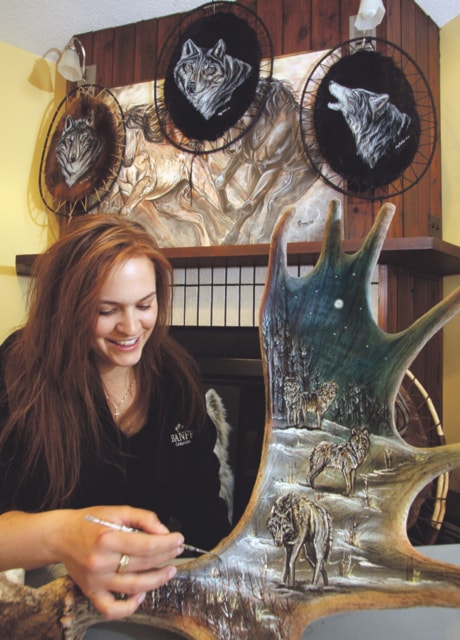Amy Keller-Rempp discovered there’s more than one way to paint wildlife.
The Red Deer area artist started out with the hyper-realistic, paint-every-hair style that won her praise as a teenager from famed wildlife artist Robert Bateman, but these days elicits yawns from many gallery owners.
Keller-Rempp heard too many artists are doing wildlife realism and the style has largely been devalued by mass-market prints.
So what’s a wildlife artist to do? Keller-Rempp tried her hand at a looser style of painting in which she attempts to capture the characteristics of the animals — the strength and energy of running horses, the stealth and mystery of wolves — and suddenly, people are becoming interested in her work.
The 27-year-old said she’s had canvases accepted in the Calgary Stampede art gallery, as well as Edmonton’s Klondike Days. An aboriginal gallery in Edmonton is also interested in carrying her paintings.
“I let myself free with big brush strokes. People are responding better and I love it,” said Keller-Rempp, who believes her larger, looser paintings contain more movement, vitality and “drama” than her formerly painstakingly detailed ones.
They take less time to complete and therefore command more affordable prices — less than $1,000 for a large canvas, compared with the more than $2,000 she was charging for realistic paintings that each took a month or more to finish.
It’s just the latest evolution of an artistic career that for Keller-Rempp started on her family’s large and remote acreage northwest of Ottawa, near Bon Echo Provincial Park.
“I grew up hunting and fishing and just appreciating nature and wildlife,” she recalled. It was the mystery and “spirit” of bears, deer, wolves and owls that made them fascinating subject matter for her paintings.
Keller-Rempp’s mother, who was half Mohawk, was a school secretary. Her father, Dale, was a pipeline worker who was diagnosed with multiple sclerosis when his daughter was only seven.
As a result, Keller-Rempp’s childhood and adolescence was a tough time for the family, financially and emotionally. She and her two sisters found it hard watching their strong, independent father gradually lose his abilities, and Keller-Rempp turned to art as escapism from the stress and sadness.
She completed many commissioned animal paintings as well as murals at her school and on the walls of area businesses. She painted animal scenes on long saw blades, and on antlers and pelts.
Once, when Robert Bateman was making a public appearance at the nearby provincial park, Keller-Rempp’s sister seized one of her paintings and pushed her way through the crowd to ask the artist’s opinion on it.
Keller-Rempp was thrilled when Bateman responded that he never would have thought the painting had been done by a 16-year-old. He confirmed that she should follow an artistic career path.
Keller-Rempp later took an “intense” year-long visual art course at Sir Stanford Fleming College in Haliburton, Ont., to expand her painting techniques.
But when her debilitated father committed suicide in 2004, she sank into a deep depression.
“I was always praying and believing every day that eventually he would walk and get better, and have a normal and happy life.”
Again it was her art and the support of family friends that helped her to heal. Keller-Rempp also credits her French-born husband, Antoine Rempp, for helping reignite her artistic interest.
She now believes she has a God-given talent that she’s supposed to share with others.
The artist, who moved to Red Deer last fall, has donated dozens of paintings to good causes, including multiple sclerosis and animal preservation charities.
She’s also expanding her interest in animals into other areas, including airbrushed pet portraits. These can be incredibly life-like without requiring the near-pointalistic technique of animal realism, said Keller-Rempp, who feels things are lining up in her favour.
For example, her husband told her about the Calgary Stampede’s early January art submission deadline just before Christmas — and just before her in-laws were due to visit from France. “I thought there’s no way I can get any paintings done on time,” she recalled.
But her husband and his parents cooked, cleaned and took over care of their animals to allow her four days of uninterrupted painting time. When the Stampede officials called to say they were accepting her work, Keller-Rempp recalled thinking, “Oh, my God, it’s a miracle!”
lmichelin@www.reddeeradvocate.com
